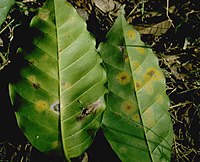
Photo from wikipedia
The devastating disease Coffee Leaf Rust, caused by Hemileia vastatrix (Hv), has been the major constraint to worldwide coffee production. Recently, Hv populations were shown to be structured into three… Click to show full abstract
The devastating disease Coffee Leaf Rust, caused by Hemileia vastatrix (Hv), has been the major constraint to worldwide coffee production. Recently, Hv populations were shown to be structured into three divergent genetic lineages with marked host specialization (C1, C2 and C3). However, there is yet no overall understanding on the population dynamics and adaptation of the most widespread and epidemiological relevant Hv group (C3). We used RAD sequencing to generate 13,804 SNPs across a worldwide collection of 99 Hv isolates. Phylogenetic analyses uncovered a well-supported structuring within C3, with three main subgroups (SGI, SGII and SGIII), which seem to reflect the historical distribution, breeding and exchange of coffee cultivars. SGI shows a ladder-like diversification pattern and occurs across all 4 continents sampled, SGII is mainly restricted to Africa and SGIII is only observed in Timor, revealing a higher genetic differentiation. Outlier and association tests globally identified 112 SNPs under putative positive selection which impacted population structure. In particular, 29 overlapping SNPs per se seemed to have an extremely strong effect on Hv population divergence. We also found exclusive and fixed alleles associated to the SGs supporting local adaptation. Functional annotation revealed that transposable elements may play a role in host adaptation. Our study provides a higher-resolution perspective on the evolutionary history of Hv on cultivated coffee, showing its strong ability to adapt and the strength of the selective force imposed by coffee hosts, which should be taken into account when designing strategies for both pathogen dissemination control and selective breeding.
Journal Title: Phytopathology
Year Published: 2022
Link to full text (if available)
Share on Social Media: Sign Up to like & get
recommendations!